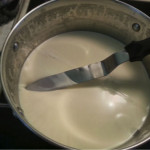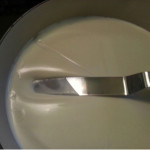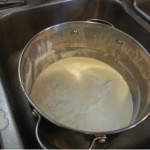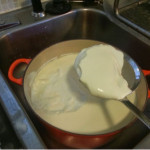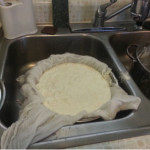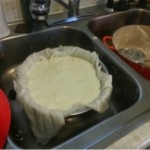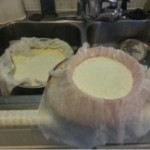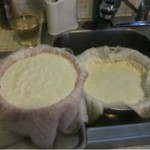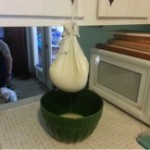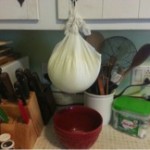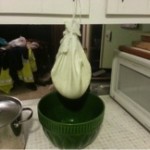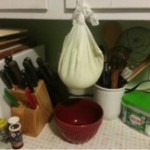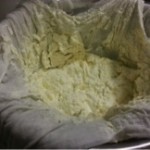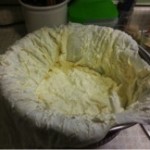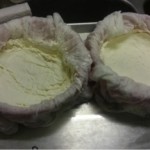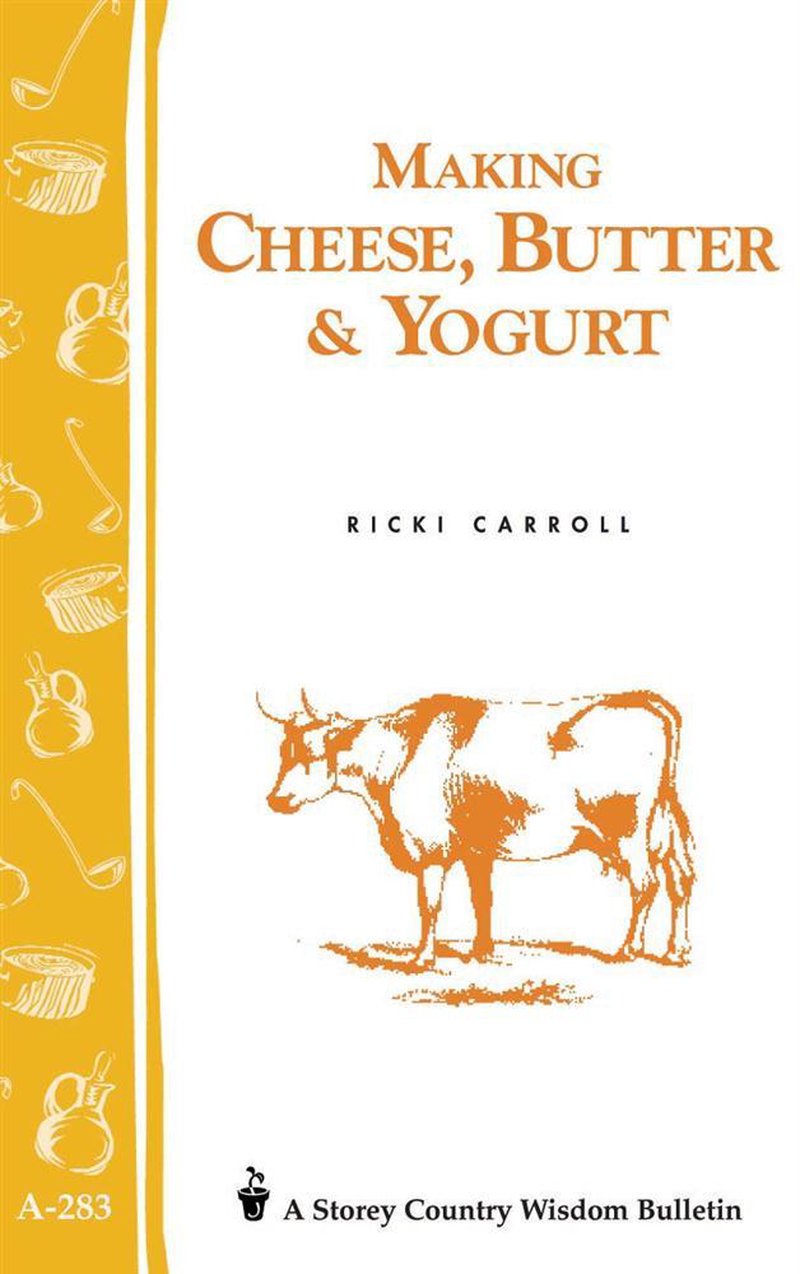
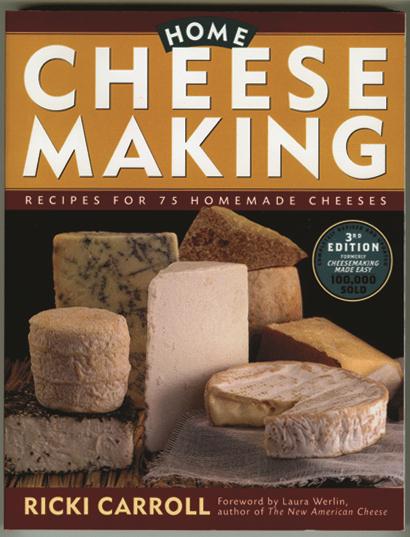 Kathy Anderson is an enthusiastic cook, and always enjoys a challenge. “Cream cheese,” she said. “How hard could it be? It’s a soft cheese, so the most it’ll take is time.” Below, she shares her adventure, step by step, including how she handled the purchase of a major ingredient! (She’s lucky: her Brownsburg, IN-area dairy delivers to her door!)
Kathy Anderson is an enthusiastic cook, and always enjoys a challenge. “Cream cheese,” she said. “How hard could it be? It’s a soft cheese, so the most it’ll take is time.” Below, she shares her adventure, step by step, including how she handled the purchase of a major ingredient! (She’s lucky: her Brownsburg, IN-area dairy delivers to her door!)
Prep: March 31, 2014
I ended up determined to try Neufchatel recipe from Home Cheese Making. I had intended to make Cream Cheese, but somehow had spaced on the fact that I was getting milk, not cream. Since I had the milk, I went for Neufchatel, which is make from milk rather than cream, although the finished texture is similar to cream cheese.
- Received two gallons Pastures Delights Dairy raw whole milk:
One gallon from 26-Mar-2014; one gallon from 30-Mar-2014.
I had no pot large enough for two gallons of milk, so I decided to experiment. I would make two batches of identical cheese, with the only variable being the milk’s date. From here on:
- “Silver” refers to the batch prepared in the stainless steel pan, with milk dated 26-Mar-2014.
- “Orange” refers to the batch prepared in the orange enameled cast iron pan, with milk dated 30-Mar-2014.
Process
- 6:15 p.m. – Set both pans on heat at setting 5 on my stove, a medium heat. Stirred both pans frequently to distribute heat.
- 6:26 p.m. – Silver over 80°F; probably 87°F at the highest. Removed from heat and continued to stir to bring down temperature.
- 6:27 p.m. – Orange batch at 81°F. Removed from heat.
-
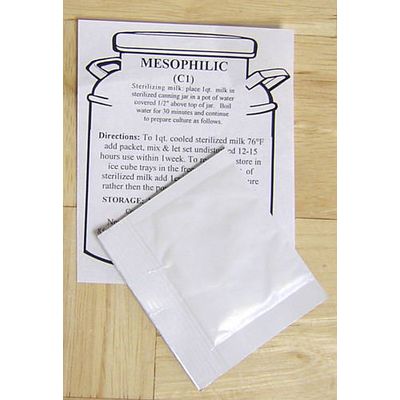
Lehman’s Cheese Starters and Supplies pack includes mesophilic starter and rennet. See more at Lehmans.com. 6:30 p.m. – Both batches at 80°F. Added to each:
1 packet Mesophilic Starter
1 tsp. Rennet, mixed from 3 drops Concentrated Vegetable Rennet dissolved in 1/3 cup cool water.
- Stirred to mix.
- Placed both pots in oven for safekeeping. (We have two cats and two dogs, one of which is a Great Dane mix. Conveniently for him, his head is counter height. This is not so convenient for us.)
April 1,2014
- 6:30 a.m. – Checked both batches. They didn’t look “like yogurt” as specified in the recipe, so I let them sit.
- 5:44 p.m. – Checked both batches using an offset frosting knife. Thickness and texture looked good.
- Set up for draining: Cut ½ piece butter muslin for each batch.
- Carefully ladled slices of Silver curd into butter muslin in mesh colander. Noticed that in addition to the curd being amazingly opaque and creamy-looking, there was a noticeable yellow layer on top. Maybe because the milk was of such good quality, there was extra butterfat?
Splitting the Batches
Turns out ½ piece butter muslin wasn’t close to having enough capacity for a 1-gallon batch where you end up with 100% soft curds instead of cut curds! The batch filled the colander to the brim, and I didn’t have enough overlap to pull the corners up and start draining.
- Second set up for draining: Put ½ piece cheesecloth in large red baskets so remaining curd could drain.
- Transferred Silver curd till it filled the red basket. This left barely enough slack in the butter muslin to create a hanging bundle, using kitchen twine.
- To keep consistent, repeated the entire process (put everything into butter muslin; then transferred part to red basket) with Orange curd.
Tied hanging bundles to kitchen cabinet handles, placing bowls beneath to catch whey.
- Placed baskets in oven for safekeeping, set on a baking sheet to catch whey.
- 9:26 p.m. – Had over 1 gallon whey, including the baking sheet being full and hard to move without spilling. Collected all whey into large pan.
April 2, 2014
- 6:36 a.m. – Had 1.75 gallons whey. Collected all whey into large pan. Didn’t like how hanging batches were draining; they still seemed very soft. Cut them down (left bundles tied) and placed the bundles in mesh colanders set over bowls to catch the whey.
- 6:00 p.m.: Unwrapped all batches. Tested texture and moisture by scooping out a spoonful of each batch.
- Texture, best to less optimal (all were still excellent):
- Orange basket
- Silver basket
- Orange hanging
- Silver hanging
- Transferred all batches to individually labeled containers.
- Stirred hanging batches (individually) to try to equalize texture. There were still lumps; probably need to whisk them.
- Collected all whey for final time. Total was a bit more than 1 ¾ gallons. Will use on plants.
Weighing and Tasting
Orange basket: 1 lb., 2 7/8 oz. (18.875 oz.)
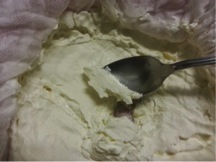
Silver basket: 1 lb., 3 ¾ oz. (19.75 oz.)
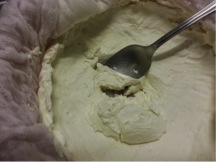
Orange hanging: 1 lb., 8 1/8 oz. (24.125 oz.)
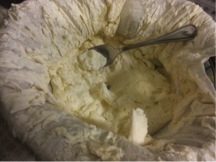
Silver hanging: 1 lb., 4 ¾ oz. (20.75 oz.)
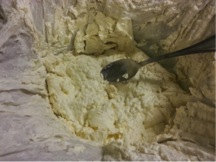
Total weight: 5 lb., 3.5 oz. (83.5 oz.)
- Orange batch total: 2 lb., 11 oz. (43 oz.)
- Silver batch total: 2 lb., 8.5 oz. (40.5 oz.)
I tasted all batches. Other than texture, the only difference I noticed was that the basket batches were less tangy, perhaps from having less whey remaining. All batches were tasty. My favorite for both taste and texture: Orange basket batch.
Conclusions
- Fresher milk (4 days younger) did have a higher yield.
- Recipe estimated yield was 2 pounds per gallon, so I imagine the high-quality raw milk is responsible for the significantly higher yield than the recipe estimate.
- This recipe (and maybe all soft-curd recipes?) benefits from going into a basket/colander directly instead of being hung first.
- No point in cutting butter muslin or cheesecloth into smaller pieces, unless to line very small molds.
- Tasty and awesome!

